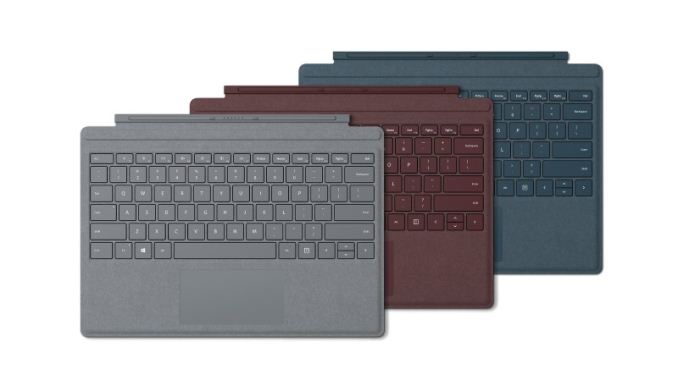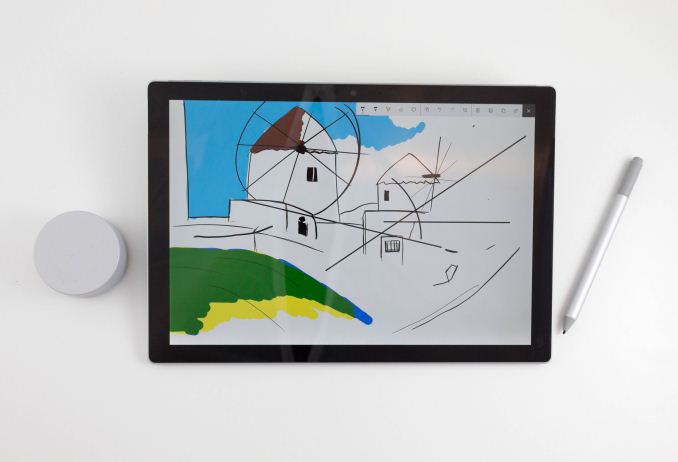The Microsoft Surface Pro (2017) Review: Evolution
by Brett Howse on June 15, 2017 9:00 AM ESTSurface Pro Signature Type Cover
It’s kind of funny that the current cover is still called the Type Cover, since the Touch Cover hasn’t been offered for several years now. Regardless, the latest Type Cover to be offered alongside the Surface Pro is a new version of the Signature model. The first Signature Type Cover was added to the Surface lineup shortly after the Surface Pro 4 was released, and it added a touch of luxury with an Alcantara fabric covering the keyboard.
The new Signature Type Cover will be offered in three colors, with Platinum, Burgundy, and Cobalt Blue options. It keeps the same design as the previous models, with 1.3 mm of key travel, and edge-to-edge island keys, so there’s not a lot of discuss there, but luckily the previous generation was already excellent.
The new Alcantara fabric is also covered with a polyurethane coating to improve durability. There’s certainly going to be some concern about how the fabric cover will hold up after several years of use and abuse, so the new coating should help alleviate some of that concern. The coating should also should help with liquid spills, and cleanup can be done with warm water and a mild detergent if needed. It feels like there’s almost no doubt that over time, the fabric will get a bit beat up, but it really does offer a nice feel when carrying the Surface Pro, or typing.
The New Surface Pen
Microsoft has been actively pushing the pen and inking experience in Windows for several years, so it makes a lot of sense that they would offer it in their own hardware products. They’ve continually improved the pen and ink on Surface for the last several years, and with the new Surface Pro, there is once again a new, improved pen.
Everyone loves to discuss the levels of sensitivity on digital pens, since unlike their analog cousins, there is always a graduated step, with the hope that there will be a small enough graduation that it’s difficult for a person to notice it. Surface Pro 3 was the first Pro model to drop the Wacom digitizer and move to an N-Trig pen technology, that Microsoft would end up acquiring shortly after. The Surface Pro 3 dropped from 1024 levels of sensitivity of the Wacom powered Surface Pro 2, to just 256 levels, but the Surface Pro 4 brought that back up to 1024 levels of sensitivity. For most people, that’s likely enough, but with Microsoft now courting the creativity crowd, the pen needed to improve further, and the new Surface Pen now offers 4096 levels of pressure sensitivity.
That’s always been the easy specification to quote for a pen, but there is a lot more to a pen experience than the levels of sensitivity. For pen fans, they’ll be happy to know that Microsoft has not overlooked those other factors with the latest generation.
One of the best features of the pen launched with the Surface Pro 4 was the tip feel. Unlike older pens, it offered a bit of traction on the display, and really made it feel more like it was actually drawing on the display. Like the previous pen, the new one also features replaceable tips, giving a choice of wider or thinner pen tips. The new pen keeps that same display friction too, which really makes it feel connected to the display.
Pen latency is arguably one of the most important aspects of a good digital inking experience, and it’s often one that gets less emphasis than other stats like pressure levels, but here the new pen improves again over the previous model, with just 21 ms of latency. Microsoft has a custom display controller to sense the pen, and with the lower latency, the latest generation is easily the best performing pen on Surface yet. One easy test to try is to draw circles on the screen quickly. The Surface Pro 4 would always have the ink lagging slightly behind where the pen was if the speed was moving quickly enough, but the new Surface Pro doesn’t have this issue at all. The ink appears to stay right under the pen.
Another unheralded feature is the amount of pressure required to start drawing, and the new Pen improves this dramatically. The outgoing version required 20 grams of force to be detected, but the new pen is just 9 grams, allowing much lighter drawing and shading options.
Finally, the one piece of the pen puzzle that Microsoft had really been lagging on was tilt support, and with the new pen, that is now available as well.
The pen is still powered by a AAAA battery, rather than being rechargeable, and battery life is expected to be around a year. The new pen also drops the pocket clip, but keeps the ability to stick to the Pro with magnets for transport. It would be nice to see a more solid mechanical device to hold the pen to the Surface, since the magnets are strong but still allow the pen to be dislodged in a bag. But for now, keep a close eye on the pen.
The new Surface Pen will work on any Surface device all the way back to and including the Surface Pro 3, and since many of the new features are part of the pen hardware, they will automatically work with other Surface devices with most of the features available. Meanwhile Microsoft is looking to upgrade the firmware of their pen controller of other Surface devices, such as the Surface Studio, to bring all of the improvements to the older hardware. The Surface Studio will really benefit from this Pen.
The final change from the Surface Pro 4 is that the pen is no longer included with the Pro. That’s because not all customers were using the pen, and it seems pretty plain that this was done in part to allow Microsoft to cut the cost of the device a bit, as we saw with the price-reduced Surface Pro 4 from earlier this year. Meanwhile for those users who do buy the new Surface Pen, it's available in colors to match the Signature Type Cover.













124 Comments
View All Comments
North01 - Thursday, June 15, 2017 - link
Great review! Hopefully you can also review the i5 model, or at least comment on the performance of their new fanless design. While I've been hearing positive things, I would really like to know how it throttles when dealing with a heavy workload.id4andrei - Thursday, June 15, 2017 - link
Only the Verge so far has received an i5 model and according to the reviewer it supposedly gets better battery life. The i7 allegedly suffers a 20% drop in battery life.ryan.bunce - Thursday, June 15, 2017 - link
The previous Surface Pros were unable to drive dual 4K screens at 60Hz. Did you happen to test the new one with two 4K screens?MattMe - Thursday, June 15, 2017 - link
This I did not know. Do you mean with the external Surface (4) dock?I'm sure I'd seen shots of people doing that. I've very sure I've seen it with the Surface Book, and that uses the same CPU SKUs at the Pro 4.
ryan.bunce - Thursday, June 15, 2017 - link
Yes with the dock, but also if you daisy chain the monitors together. Here's a couple of articles from folks who've noted it:http://tiamat.tsotech.com/surface-book-incapable-o...
https://www.petri.com/run-two-4k-monitors-surface
Brett Howse - Thursday, June 15, 2017 - link
This is a limitation of the Intel GPU. It only provides DisplayPort 1.2 streams, so you can only connect one UHD/60Hz display per stream. There are two though, since you can connect one on the dock, and one on the device itself, so you can run 2 UHD/60Hz but the cabling is a bit silly.ryan.bunce - Friday, June 16, 2017 - link
So must be the two port on the SP4 Dock are just daisy chained on the same channel. Makes sense - all the more reason why a thunderbolt port on the SP would be great.soliloquist - Thursday, June 15, 2017 - link
I always wanted to see a detailed thermal/throttling test between the i5 and the i7 on the SP4 and would be even more interesting with the 2017 SP (since the i5 is fanless).Really wish you would have run the thermal test a little longer. In your original SP4 tests you really didn't see the thermal limits reached until around 25 mins (which is when you stopped testing this time).
http://www.anandtech.com/show/9727/the-microsoft-s...
From this article you say "The Iris does allow a lot more graphics potential, but for longer duration requirements, it may not offer much of an upgrade."
This is what I would really like to see examined. Is the extra money for the i7 really worth it, particularly when longer durations are taken into account.
Thanks for the great write up otherwise.
Brett Howse - Thursday, June 15, 2017 - link
I'll run a longer test and let you know how I make out. The temperatures were stable though so it *should* be the same, but I can try this and let you know.soliloquist - Friday, June 16, 2017 - link
Thanks. Will look for it!